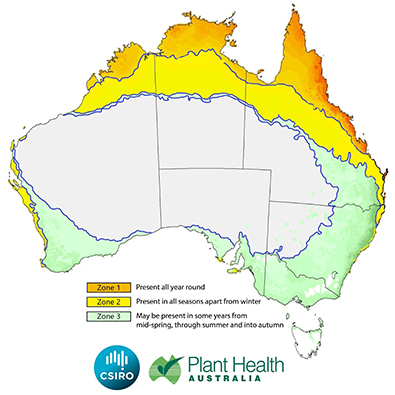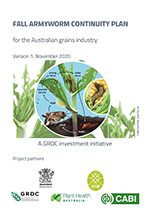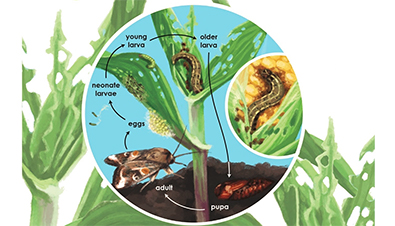Read the latest information on
Foot-and-mouth disease

The Fall Armyworm Continuity Plan maps out zones likely to be at risk from fall armyworm
Since its detection across northern parts of Queensland, NT and WA in February 2020, fall armyworm (Spodoptera frugiperda) has been quick to establish in these locations, but Plant Health Australia (PHA) has announced new resources to assist in defending crops against the pest.
Stuart Kearns, National Manager for Preparedness and RD&E at PHA, said that the threat posed by fall armyworm prompted concerted efforts to find out about its likely effects in Australia and how best to manage it.
“As fall armyworm is new to Australia, we are relying on information and experience from overseas until locally generated data is developed to bolster this information.”
In unmanaged situations, fall armyworm has been known to decimate crops overseas, specifically maize, sweetcorn and sorghum, but in all, the pest has been observed on 350 different plant species with 11 crop industries potentially at risk.
“We have sourced knowledge from around the world to develop a new reference guide on the pest, together with a series of podcasts, that will help industry manage the invasive moth species,” Stuart said.
“The information assembled includes how to scout for and recognise the pest, its lifecycle and biology, estimated areas at risk, and management practices that will help to limit the damage it causes.”
 The Fall Armyworm Continuity Plan for the Australian Grains Industry was a Grains Research Development Corporation investment initiative led by cesar with project partners PHA, Centre for Agriculture and Bioscience International, and the Queensland Department of Primary Industries.
The Fall Armyworm Continuity Plan for the Australian Grains Industry was a Grains Research Development Corporation investment initiative led by cesar with project partners PHA, Centre for Agriculture and Bioscience International, and the Queensland Department of Primary Industries.
The 75 page document is intended for use as a reference guide that provides a basis for designing area wide management plans, crop specific management manuals and strategies to avoid resistance to chemical controls.
The other resource, a series of podcasts, aimed primarily at agronomists and growers, will prepare farm businesses for potential impacts.
Funded by Plant Biosecurity Research Initiative (PBRI) members and produced by PHA, the podcasts are available for free from the PBRI website and will also be made available through Apple Podcasts, Google Podcasts, Spotify and Fireside. Each episode runs for about 30 minutes.
Stuart Kearns urges industries, agronomists and producers to find out about fall armyworm, and the risk it poses to their businesses, since it has been determined that it is unfeasible to eradicate.
“Unfortunately, this moth is here to stay. After it was detected in the north of Australia earlier this year it has spread rapidly southwards on prevailing winds,” he said.

To manage fall armyworm, it helps to understand its lifecycle
“While these northern areas are likely to host fall armyworm populations in crops, pastures and weeds, it is difficult to know just how significant a pest fall armyworm will be in the regions further south.”
Stuart says early detection is critical to controlling populations which can build up quickly if unchecked. He advises actively monitoring the presence, population, and movement of the new pest in your region.
“No one knows exactly how this new pest will behave in crops and regions in Australia, but it’s best to get on the front foot and prepare for its arrival,” Stuart said.
The podcast project, coordinated by PBRI was co-funded by the Cotton Research and Development Corporation, AgriFutures Australia, the Grains Research and Development Corporation, Hort Innovation and Sugar Research Australia.